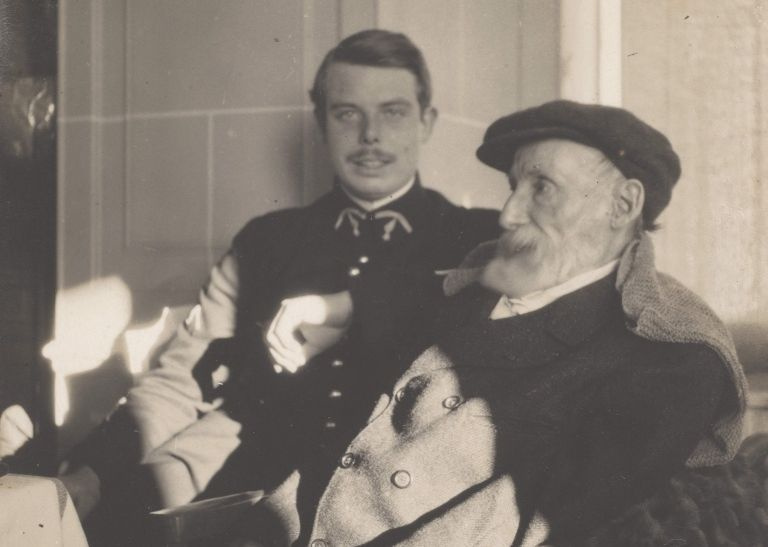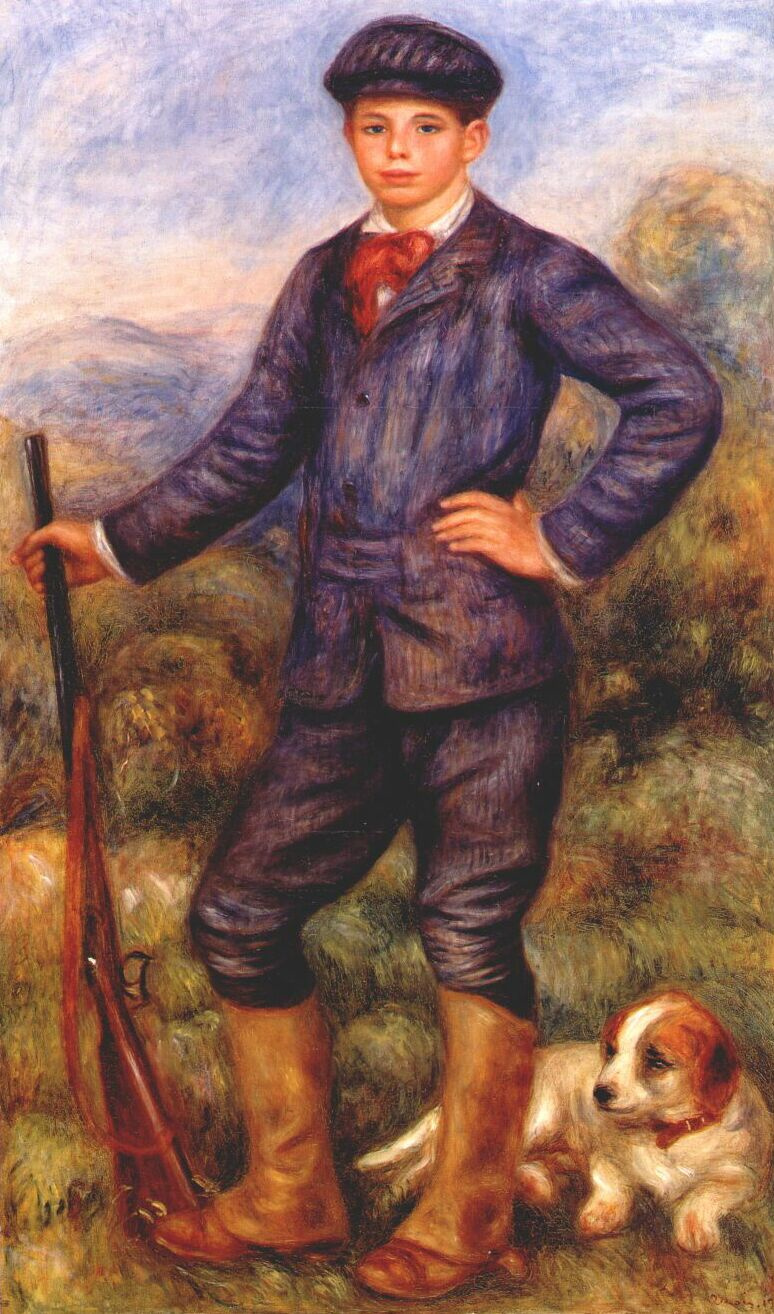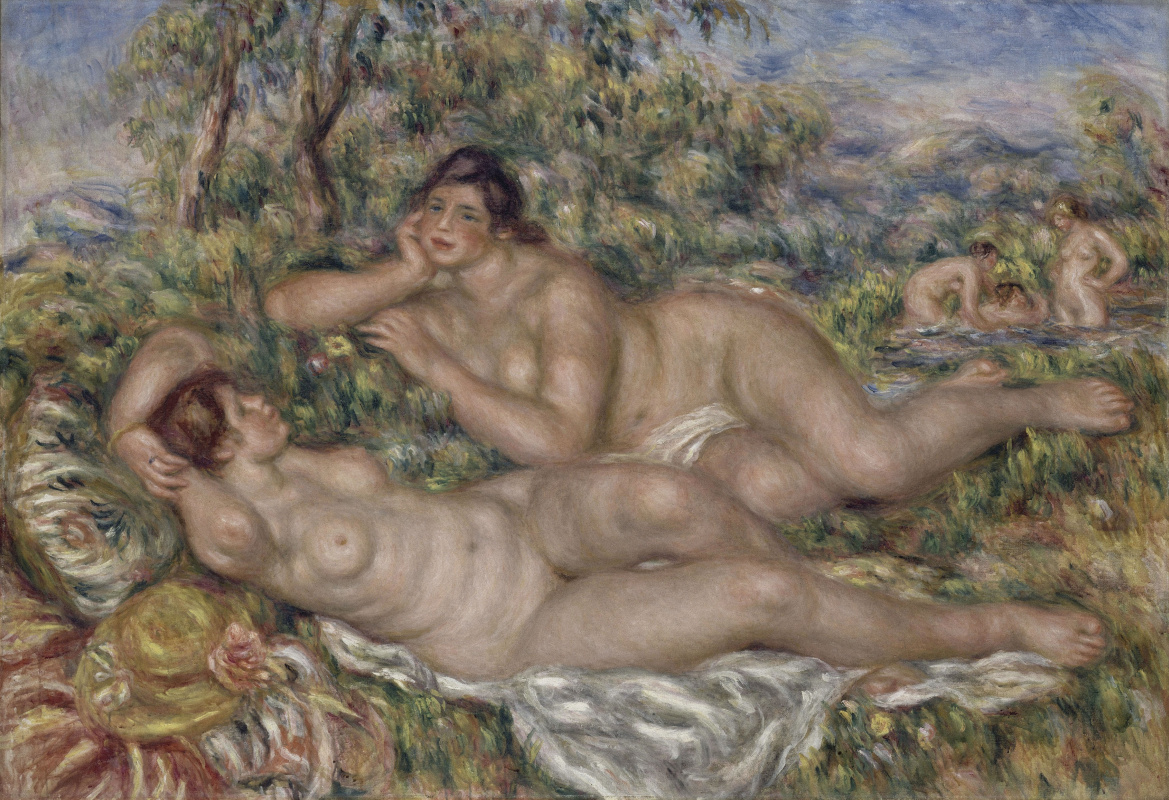"Renoir: Father and Son / Painting and Cinema" exhibition is currently on view at the Barnes Foundation, Philadelphia, USA until September 3, 2018. Barnes' collection of Jean Renoir pottery in addition to 181 works by Pierre-Auguste Renoir provides a poignant setting for exploring complex, fruitful and sometimes paradoxical relationship between father and son and between painting and cinema. Viewers have a chance to comprehend how Pierre-Auguste Renoir’s artistic practice and creative universe influenced Jean’s art, and Jean’s films shed light on his father’s paintings.

"Father and Son/Painting and Cinema" at the Barnes Foundation that has opened on May 6, 2018 brings together over 120 works, including paintings, drawings, ceramics, film excerpts, costumes, photographs, posters, and documents—many never before shown in the US—forming the multidisciplinary exhibition that explores the Pierre-Auguste's role in his son’s oeuvre and the relationship between painting and cinema.
The exhibition is organized by the Barnes Foundation, Philadelphia, and the Musées d’Orsay et de l’Orangerie, Paris, in collaboration with La Cinémathèque française, Paris. It is curated by Sylvie Patry, Consulting Curator at the Barnes and Chief Curator/Deputy Director for Curatorial Affairs and Collections at the Musée d’Orsay. When the exhibition ends on September 3 at the Barnes, it will then travel to Paris and continue at the Musée d’Orsay from 06 November 2018 to 27 January 2019.
The exhibition is organized by the Barnes Foundation, Philadelphia, and the Musées d’Orsay et de l’Orangerie, Paris, in collaboration with La Cinémathèque française, Paris. It is curated by Sylvie Patry, Consulting Curator at the Barnes and Chief Curator/Deputy Director for Curatorial Affairs and Collections at the Musée d’Orsay. When the exhibition ends on September 3 at the Barnes, it will then travel to Paris and continue at the Musée d’Orsay from 06 November 2018 to 27 January 2019.
A good place to start observing the relationship between the two Renoirs is the 'album' of Jean’s early childhood made by Pierre-Auguste Renoir. The artist created around 60 portraits of his second son Jean. When producing early ones, Pierre-Auguste insisted on a silky, auburn-colored mane of the child. So, Jean was not allowed to get a haircut for years as a child, until actually the third son, Claude, the beloved model of the master, was born.
Jean Renoir had some vivid recollections of that period: "When I was still very little, three, four or five years old, my father did not tell me how I was to pose but took advantage of some occupation that seemed to keep me quiet."
Jean Renoir had some vivid recollections of that period: "When I was still very little, three, four or five years old, my father did not tell me how I was to pose but took advantage of some occupation that seemed to keep me quiet."
Jean as a Huntsman
1910
By the time Jean was 16 years old, he grew up into a tall, handsome teenager with a short hair cut, as evidenced in one of his father’s largest-scale portraits, Jean as a Huntsman (1910).
Jean liked this painting most of all other father’s works. He kept it for his entire life on a prominent and permanent display in his living room, even though he moved from France to USA and back and could have chosen any other canvas painted by his father, as he was one of the inheritors of the Pierre-Auguste's oeuvre after the master’s death in 1919. The brothers gifted some of the paintings to museums, others they kept for themselves, and many were sold, sometimes to finance Jean’s films.
"In his career, [Jean as a Huntsman] is really an accomplishment," Sylvie Patry—curator of the exhibition, chief curator at the Musée d’Orsay, and consulting curator at the Barnes—told in an interview. "The Impressionist painter is integrating the great tradition in his own art; this picture is a very ambitious one."
Pierre-Auguste posed his adolescent son in the full-scale format of a portrait, once reserved for nobility. Like a prince at leasure, Jean has just descended from his steed after fabulous hunting with his loyal companion, a dog. His somewhat antiquated trappings of princely gown, a dog and rifle, a nonchalant hand resting on the hip refer us to Old Masters, and to the best of them in the genre of full-length portraits, Diego Velázquez and Peter Paul Rubens.
We can clearly see a personal connection between the father and the son in this portrait. But there is more to it. As a master of a modern style, Pierre-Auguste reinterpreted here the artistic tradition of the past in his unique Impressionist way. Similarly, his son Jean metamorphosed the colorful-yet-motionless world painted by his father into a dynamic, new black-and-white and later color art of cinema.
Jean liked this painting most of all other father’s works. He kept it for his entire life on a prominent and permanent display in his living room, even though he moved from France to USA and back and could have chosen any other canvas painted by his father, as he was one of the inheritors of the Pierre-Auguste's oeuvre after the master’s death in 1919. The brothers gifted some of the paintings to museums, others they kept for themselves, and many were sold, sometimes to finance Jean’s films.
"In his career, [Jean as a Huntsman] is really an accomplishment," Sylvie Patry—curator of the exhibition, chief curator at the Musée d’Orsay, and consulting curator at the Barnes—told in an interview. "The Impressionist painter is integrating the great tradition in his own art; this picture is a very ambitious one."
Pierre-Auguste posed his adolescent son in the full-scale format of a portrait, once reserved for nobility. Like a prince at leasure, Jean has just descended from his steed after fabulous hunting with his loyal companion, a dog. His somewhat antiquated trappings of princely gown, a dog and rifle, a nonchalant hand resting on the hip refer us to Old Masters, and to the best of them in the genre of full-length portraits, Diego Velázquez and Peter Paul Rubens.
We can clearly see a personal connection between the father and the son in this portrait. But there is more to it. As a master of a modern style, Pierre-Auguste reinterpreted here the artistic tradition of the past in his unique Impressionist way. Similarly, his son Jean metamorphosed the colorful-yet-motionless world painted by his father into a dynamic, new black-and-white and later color art of cinema.
"I have spent my life trying to determine the extent of the influence of my father upon me," Jean wrote in his 1974 memoir, My Life and My Films, "passing over the periods when I did my utmost to escape from it to dwell upon those where my mind was filled with the precepts I thought I had gleaned from him."

Still frame
from Picnic on the Grass (1959), directed by Jean Renoir. © 1959 Studiocanal. Photo: credit to Barnes Foundation
After World War I, Jean Renoir followed his father’s suggestion and tried his hand at making ceramics. Dr. Albert C. Barnes assembled the largest holding of Jean’s pottery in the world (40 pieces) in the early 1920s, and the exhibition Father and Son/Painting and Cinema displays a significant portion of the Barnes collection for the first time.
Soon Jean Renoir set pottery aside to make films. As a film director and actor, he made more than forty films from the silent black-and-white era to the sound and color movies at the end of the 1960s. He is acclaimed as one of the most influential directors of the 20th century and noted for such masterpieces as 1937's "Grand Illusion," 1939's "Rules of the Game", 1945's "The Southerner," and "A Day in the Country" (shot in 1936 and released in 1946). All of them are considered milestones in the history of 20th-century art.

Dana Andrews, Anne Baxter and director Jean Renoir on the set of L'étang Tragique (Swamp Water), 1941. Photo: credit to moncinemaamoi.blog
"If certain landscapes, certain costumes, bring to mind my father’s paintings," Jean said about one of his films, Partie de campagne (A Day in the Country, 1936), in an interview with Cahiers du Cinéma, "it's for two reasons: first, because it takes place during the period and in a place where my father worked a great deal in his youth. Second, it’s because I’m my father’s son, and one is inevitably influenced by one’s parents."
"Jean Renoir was a pioneer in making movies outdoors," Matthieu Orlean of La Cinémathèque Française said.
The exhibition shows that when practicing filming outdoors, Jean followed the suit of Impressionists who took their easels to the countryside. He recaptured beloved scenery depicted by his father and other painters of Pierre-Auguste's generation and experimented with natural light, so much adored by the Impressionists.
Jean shot his films at the French locales where his father and other Impressionists preferred to paint en plein air—like Marlotte, Paris, and Cagnes-sur-Mer. And for his scripts, he quite often chose works of great writers from the 19th century such as Flaubert, Maupassant, Gorky and Zola. Jean’s Nana (1926) is based on an Émile Zola novel; and French Cancan (1955), inspired by Parisian dance halls, such as the Moulin Rouge.
The scenery and time period of Pierre-Auguste's paintings have influenced Jean’s picturesque film scenes incredibly.
The exhibition shows that when practicing filming outdoors, Jean followed the suit of Impressionists who took their easels to the countryside. He recaptured beloved scenery depicted by his father and other painters of Pierre-Auguste's generation and experimented with natural light, so much adored by the Impressionists.
Jean shot his films at the French locales where his father and other Impressionists preferred to paint en plein air—like Marlotte, Paris, and Cagnes-sur-Mer. And for his scripts, he quite often chose works of great writers from the 19th century such as Flaubert, Maupassant, Gorky and Zola. Jean’s Nana (1926) is based on an Émile Zola novel; and French Cancan (1955), inspired by Parisian dance halls, such as the Moulin Rouge.
The scenery and time period of Pierre-Auguste's paintings have influenced Jean’s picturesque film scenes incredibly.

On the set of Jean Renoir’s La Règle du jeu (The Rule Of The Game, 1939). Jean is in the background on the right. Photo credit: moncinemaamoiblog.com
"It is quite an exceptional, if not unique, situation in the history of art, to have a father and son play such significant roles in their field. Inventing impressionism
alongside his friends, Pierre-Auguste Renoir deeply renewed the art of his time. Jean Renoir, early in the history of cinema, invented new images. It is fascinating to see that Jean often referred to his father’s art and time in his films. However, their relationship was complex and oscillated between moments of admiration and rejection," says Sylvie Patry."If Pierre-Auguste's artistic practice and creative universe at some points influenced Jean’s art, Jean’s films shed light on his father’s paintings. The Barnes… is a fascinating setting to explore both the artistic relationship between father and son and how painting and cinema illuminate each other in many ways."

Pierre Auguste Renoir and Andrée-Madeleine Heuschling at the artist’s studio at Les Collettes in Cagnes, 1918
There are more personal ways of influence between the two Renoirs than father’s painting affecting son’s filming style.
When Jean, wounded at World War I, returned to his father’s house after spending quite a while at the hospital, he was amazed by the beauty that was posing for Pierre-Auguste. His father’s last model’s name was Andrée-Madeleine Heuschling and she was a local bakery girl who joined the Renoir household in order to help care for the ageing artist. She was then aged around 16. This young girl nicknamed "Dédée" was a driving force for the old, sick, widowed Renoir.
When Jean, wounded at World War I, returned to his father’s house after spending quite a while at the hospital, he was amazed by the beauty that was posing for Pierre-Auguste. His father’s last model’s name was Andrée-Madeleine Heuschling and she was a local bakery girl who joined the Renoir household in order to help care for the ageing artist. She was then aged around 16. This young girl nicknamed "Dédée" was a driving force for the old, sick, widowed Renoir.
Bathers
1919, 110×160 cm
"She is so beautiful! I have worn out my old eyes looking at her young skin, and I saw that I was not an old master but a child", Pierre-Auguste Renoir is supposed to have declared.
The Bathers above features both Madeleine Bruno (Renoir's model in 1910s and Andrée-Madeleine Heuschling). It is one of the master’s very last works, his paean to peace in celebration of the end of World War I.
As Jean confirmed in the book he dedicated to his father, Dédée seems to have brightened up the last years of the painter’s life: "she was sixteen years old, red-haired, plump, and her skin ‘took the light' better than any model that Renoir had ever had in his life. She… was gay, and cast over my father the revivifying spell of her joyous youth."
Note, bellow Dédée is depicted in the same exotic blouse which she is wearing in a photograph above posing next to the artist.
The Bathers above features both Madeleine Bruno (Renoir's model in 1910s and Andrée-Madeleine Heuschling). It is one of the master’s very last works, his paean to peace in celebration of the end of World War I.
As Jean confirmed in the book he dedicated to his father, Dédée seems to have brightened up the last years of the painter’s life: "she was sixteen years old, red-haired, plump, and her skin ‘took the light' better than any model that Renoir had ever had in his life. She… was gay, and cast over my father the revivifying spell of her joyous youth."
Note, bellow Dédée is depicted in the same exotic blouse which she is wearing in a photograph above posing next to the artist.
Blond Girl with Rose
1917, 64×54 cm
Jean Renoir fell in love with the girl and married his father’s beloved last model in a month after Pierre-Auguste's death. She inspired the younger Renoir to step out from his father’s shadow and become a filmmaker. He would later claim that he became a film director to try to make Hessling a star.
In four year she began a career as an actress under the name of Catherine Hessling, in one of the first films scripted by Jean Renoir. She acted as a leading actress in five more silent films directed by her husband. They were married for 11 years and had a son Jacques, who directed many films and television series, including The Undersea World of Jacques Cousteau.
In four year she began a career as an actress under the name of Catherine Hessling, in one of the first films scripted by Jean Renoir. She acted as a leading actress in five more silent films directed by her husband. They were married for 11 years and had a son Jacques, who directed many films and television series, including The Undersea World of Jacques Cousteau.

Catherine Hassling and Jean Renoir
You can easily notice that Hessling on photographs looks very different from Pierre-Auguste's paintings. It was typical of Renoir’s later style to add rosiness and imaginary curves to the young woman’s lithe, flapper-era body.
Pierre-Auguste felt that his role as an artist was to provide joy and gaiety to people, according to Sylvie Patry. She says he believed that the mission of the artist was to create a world to enjoy, the positive, the sunny side of life.
The same was done by his son, Jean Renoir, in cinema. He was able to implement motifs of joy and gaiety in his own films: pairs waltzing, people having picnics, and women showing up nude near ponds, just like in Renoir paintings. Perhaps most of all, the father’s escapist approach to art influenced the movie-making of his son.
Pierre-Auguste felt that his role as an artist was to provide joy and gaiety to people, according to Sylvie Patry. She says he believed that the mission of the artist was to create a world to enjoy, the positive, the sunny side of life.
The same was done by his son, Jean Renoir, in cinema. He was able to implement motifs of joy and gaiety in his own films: pairs waltzing, people having picnics, and women showing up nude near ponds, just like in Renoir paintings. Perhaps most of all, the father’s escapist approach to art influenced the movie-making of his son.
Bathers
1894
"Renoir: Father and Son / Painting and Cinema" is on view from May 6 to September 3, 2018 at the Barnes Foundation, Philadelphia, USA.
Written on materials of barnesfoundation.org, m.musee-orsay.fr, musee-orangerie.fr, artsy.net, artdaily.com, renoirexperts.com, moncinemaamoi.blog, spinstrangenesscharm.wordpress.com, sothebys.com. Title illustration: Photograph of Pierre-Auguste Renoir and his son Jean Renoir. Photo credit: Musée d’Orsay.






















